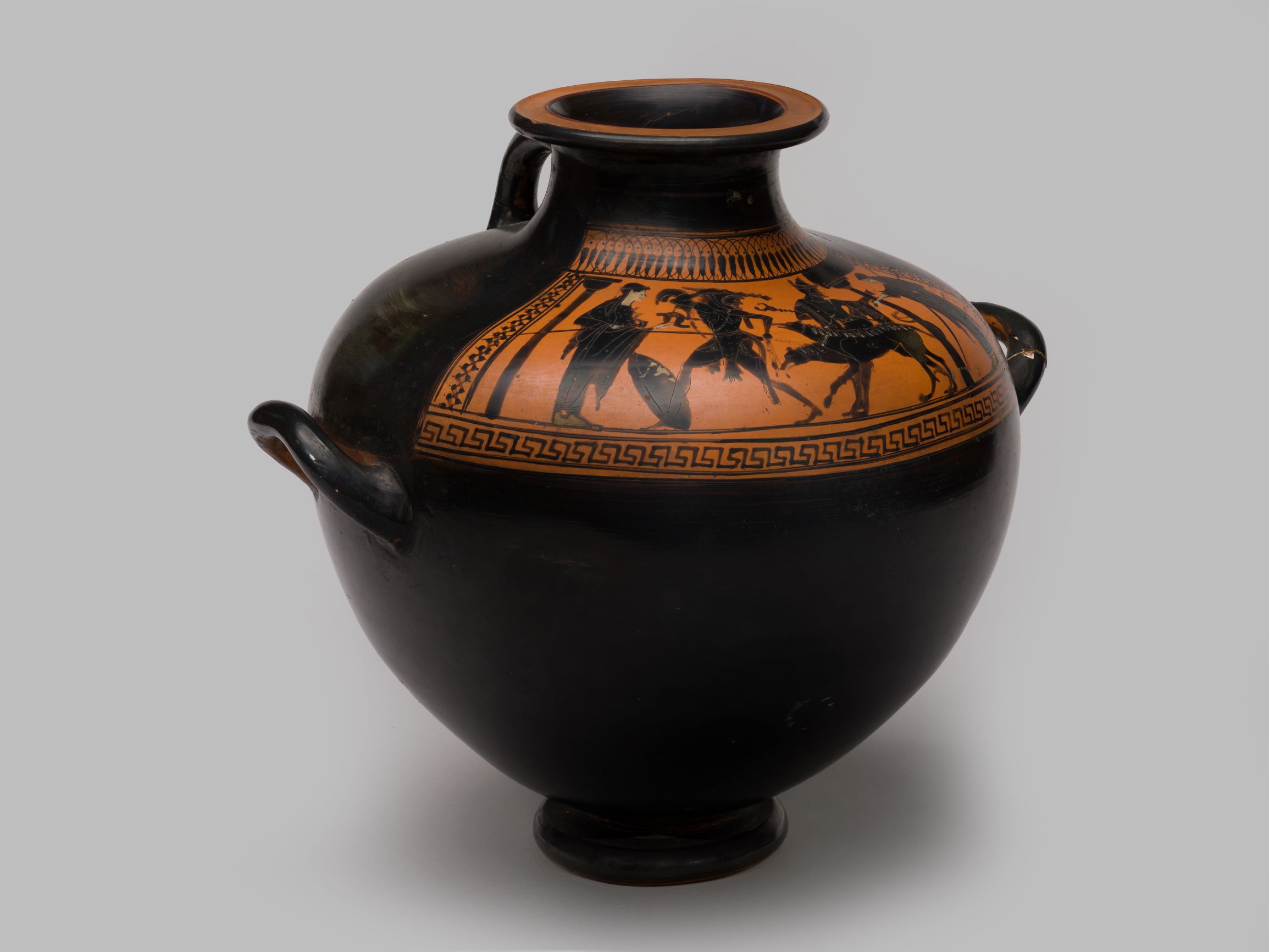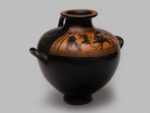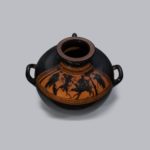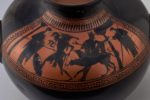
Kalpis Hydria [Gr16]
Athenian Black-Figure, 510-490 BC
Painted terracotta (h. 32.1 cm, w. 36.5 cm), the foot and one handle mended
Painted black except the area between the handle roots and a panel on the shoulder showing Herakles and Kerberos in Hades, accompanied by Athena, Hermes and Persephone.
This vase depicts Herakles’ final labour, bringing Kerberos, the guardian of the underworld, to King Eurystheus. On the far left is a Doric column, indicating the entrance to Hades, beside which stands Athena, her hair bound in a tainia. In her left hand she holds an Athenian helmet, and in her right a spear. Her shield is emblazoned with a bull’s head and rests on the ground. Herakles strides towards Athena while looking back at Kerberos. He wears a belted lion-skin and in his right hand brandishes a club. His left hand holds a chain by which he leads the two-headed Kerberos. Behind him is Hermes, who strides to the left, turning back to gesture towards Persephone. He wears the petasos (traveller’s hat) and a winged sandal. He holds the kerykeion (herald’s staff) – a golden wand with two snakes entwined around it. A column and architrave mark the palace of Hades where Persephone, queen of the underworld, stands in the entrance.
This complex design was marked out by incising lines into the surface of the clay before painting had begun. These are still visible around each figure, especially where the paint filling in Herakles’ body does not quite match the incised outlines. Incision was also used after painting to add internal details to the figures, for example the markings on Kerberos’ fur. The assurance and intricacy of these lines is crucial to the visual appeal of this high-quality vase. Unlike on many other black-figure vases, added colour has been used quite sparingly.
Mythological scenes began to appear on Greek vases around 700 BC, and by the early 6th century they had become a common form of decoration. This development was encouraged by the introduction of the black-figure technique, which made the forms and gestures of the figures stand out with great clarity against their background, allowing painters to depict complex narrative scenes. The study of vases can often contribute to our understanding of Greek myths, as the scenes depicted sometimes differ significantly from the stories preserved in literature. In this case, the scene on this vase conforms quite closely to the earliest written account of Herakles’ final labour, in Homer’s Odyssey (c. 700 BC): ‘I brought the dog up and led him from the realm of Hades, and Hermes saw me on my way, with Pallas Athene.’ (XI, 625-26). Later writers, including Sophocles and Euripides, describe Kerberos as three-headed, but here (and on some other vases), he has only two heads.
This vase is a hydria (water jar), of a round-shouldered type known as a kalpis. It was held horizontally by the side handles when full, and the handle on the back helped when pouring. One of the Parthenon Frieze casts in Winchester’s collection shows three women carrying hydriai like this one. Many hydriai have survived because they were commonly dedicated as grave goods. The bottom of this vase is marked with a symbol, incised into the clay after firing. This may be a trademark placed on the vase by the potter, or perhaps a mark of ownership, but its exact meaning is unclear.
This is one of the few vases at Winchester for which a complete record of its provenance (past ownership) survives. It was originally in the collection of Lucien Bonaparte, brother of Napoleon, who excavated thousands of Greek vases from Etruscan tombs on his estates in central Italy. After being sold by Canino in 1839, this vase belonged to two of the most discerning 19th-century collectors of Greek vases, the poet Samuel Rogers and William Henry Forman. It was given to Winchester by Arthur Kemball Cook, Assistant Master from 1875-1911 and housemaster of Du Boulay’s, along with Gr18.
Literature: R. Foster, Winchester College Treasury: a guide to the collections (Winchester, 2016), pp. 46-47; J. Falconer and T. Mannack, Corpus Vasorum Antiquorum: Great Britain, Fascicule 19: Winchester College (Oxford, 2002), pp. 5-6, plate 5.1-3; Lexicon Iconographicum Mythologiae Classicae, Vol V (Zurich, 1990), 91.2603; C.A. Picón, Classical Antiquities from Private Collections in Great Britain (London, 1986), p. 23 (no. 17), plate IV; Winchester College Memorial Buildings: Department of Classical Art (Winchester, 1909), p. 17 (no. 41)
Exhibited: Sotheby’s, London, 1986
Provenance: Excavated near Vulci, Italy, c. 1830; collection of Lucien Bonaparte, Prince of Canino (1775-1840), no. 2673; Samuel Rogers (1763-1865), his sale Christie’s, London, 1/5/1856, lot 484 (19-8-6, to W.H. Forman); William Henry Forman (1794-1869), his sale Sotheby’s, London, 19/6/1899, lot. 287 (18-0-0 to Rollin & Feuardent, Bloomsbury); Arthur Kemball Cook, by whom given before 1909


